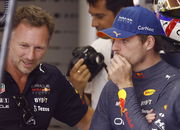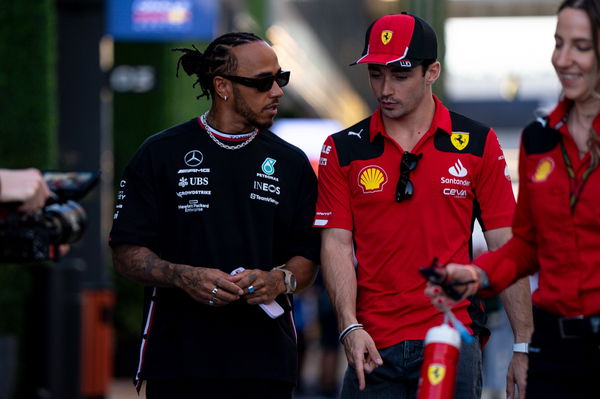
Reuters
Formula One F1 – Saudi Arabian Grand Prix – Jeddah Corniche Circuit, Jeddah, Saudi Arabia – March 16, 2023 Mercedes’ Lewis Hamilton and Ferrari’s Charles Leclerc ahead of the Grand Prix REUTERS/Hamad I Mohammed

Reuters
Formula One F1 – Saudi Arabian Grand Prix – Jeddah Corniche Circuit, Jeddah, Saudi Arabia – March 16, 2023 Mercedes’ Lewis Hamilton and Ferrari’s Charles Leclerc ahead of the Grand Prix REUTERS/Hamad I Mohammed
Mercedes was scrutinized for blowing Lewis Hamilton’s chances of winning the United States GP. Mercedes’ pit strategy cost the Briton a chance to win the race as he finished P2 just 2 seconds behind Max Verstappen. The 7x was overjoyed with the better performance. However, it was short-lived as he, along with Charles Leclerc, was disqualified from the US GP. But why were they disqualified?
Watch What’s Trending Now!
It was a result of not being able to pass the post-race plank check done by the FIA. Both Lewis Hamilton and Charles Leclerc failed to meet the parameters set up by the FIA when their cars were checked. As a result of disqualification, Carlos Sainz made it onto the podium positions with George Russell getting inside the Top 5.
BREAKING: Lewis Hamilton and Charles Leclerc have been disqualified from the 2023 United States Grand Prix for a technical infringement#F1 #USGP pic.twitter.com/HHNlf5urLW
— Formula 1 (@F1) October 23, 2023
ADVERTISEMENT
But what exactly is this wooden plank for? Why is it fitted to an F1 car? Let’s take a look at the history of this plank and how it is crucial for the FIA to mandate it.
What is the role of the wooden plank underneath an F1 car? Why does the FIA conduct its post-race check?
The wooden plank, also known as a skid block, is a long piece of wood that is attached to the bottom of an F1 car. These were first introduced in F1 for the 1994 season. FIA mandated these wooden planks to the floor of the cars as it would help the governing body during the post-race inspection. But many of you might still be wondering, why put a wooden plank on state-of-the-art machinery?
ADVERTISEMENT
Well, this is because the skid block helps impose a minimum ground clearance for the F1 cars. It helps to make sure that teams do not run their car too low. If they do, then the wooden plank will scrape the floor. Every time the plank scrapes, it sheds a bit. If excessive scrapping is there, FIA would get to know that teams were running the car too low. The skid block’s role has become even more crucial in this ground effect era of F1, where the cars are essentially being sucked onto the floor.
Teams can gain a significant advantage if the car is run close to the ground. However, in these ground-effect cars, running too close to the ground might stall the underfloor and the car would lose the downforce all of a sudden. Hence, FIA checks the plank for wear. Let’s see where it went wrong for Hamilton and Leclerc.
ADVERTISEMENT
Read More: “I Hate Losing”: As Toto Wolff Reacts Boldly, Lewis Hamilton Looks at Silver Lining Amid US GP Chaos
Top Stories
Mercedes Faces F1 Uproar as Toto Wolff’s Team Nears Clean Chit on ‘Illegal’ Engine

Where Does Max Verstappen Live Stream?

Netflix Excludes Red Bull From Drive to Survive as All 10 Episode Descriptions Get Released

“This Is a Joke Right?”: Rebecca Donaldson and Alexandra Saint Mleux’s Endorsement of F1 Academy Leaves Fans Fuming

Frederic Vasseur’s Humility Wrapped Up in Humour Has Tifosi Adoring Their New TP: “Exactly What Ferrari Needed”

Why did Lewis Hamilton and Charles Leclerc get disqualified? What was wrong with their planks?
The FIA has a set of checks mandated after the race. At every race, the FIA picks cars at random since it is not feasible to conduct all the tests on all of the cars. For the US GP, the FIA selected one driver from the Top 4 teams. Max Verstappen from Red Bull, Lewis Hamilton from Mercedes, Charles Leclerc from Ferrari, and Lando Norris from McLaren were the 4 drivers whose cars got checked.
ADVERTISEMENT

Imago
March 16, 2023, Jeddah, Saudi Arabia: LEWIS HAMILTON of Great Britain and Mercedes-AMG F1 Team and CHARLES LECLERC of Monaco and Scuderia Ferrari are seen in the paddock during preparations of the 2023 FIA Formula 1 Saudi Arabian Grand Prix at Jeddah Corniche Circuit in Jeddah, Saudi Arabia. Jeddah Saudi Arabia – ZUMAg147 20230316_zap_g147_022 Copyright: xJamesxGasperottix
Lewis Hamilton and Charles Leclerc failed to meet the requirements of the plank set by the FIA. They were found to be in breach of the Article 3.5.9 of F1’s 2023 Technical Regulations. It states, “The thickness of the plank assembly measured normal to the lower surface must be 10mm [plus or minus] 0.2mm and must be uniform when new. A minimum thickness of 9mm will be accepted due to wear, and conformity to this provision will be checked at the peripheries of the designated holes.”
Out of all the 4 cars that were tested, Lewis Hamilton and Charles Leclerc failed the plank test. The thickness of the plank was below the limit of 9mm, which is set by the FIA. However, Mercedes and Ferrari did send their representatives to the stewards, as they implied that many external factors also added to the wear.
ADVERTISEMENT
Was Mercedes or Ferrari responsible for the failed plank test? Were there any external factors?
Failing a plank test isn’t a common form of disqualification. Out of the 4 cars that were tested, 2 failed the test. One can only imagine what the result would’ve been like if all the cars were tested. And some factors come to mind if we look at things from a broader perspective. Let’s see some plausible reasons that might’ve caused the plank to wear beyond the regulation limit.
Our Sporting Director, Diego Ioverno, explains @charles_leclerc’s disqualification from the #USGP pic.twitter.com/cZFEvInIuc
— Scuderia Ferrari (@ScuderiaFerrari) October 23, 2023
ADVERTISEMENT
The first thing that both the teams did was point fingers at the Sprint format. The teams just have 1 hour of practice before the cars get locked in the Parc Ferme. Teams don’t get the time to run the cars with heavy fuel in the practice session, hence setting the car up for the race becomes tricky. Another factor that comes to mind is the new Mercedes floor that they brought to the US GP. It very well could’ve been the reason behind the failed plank test.
But given the fact that Ferrari didn’t bring any upgrades to the floor, it seems to be an external reason behind the failing of the plank test. The resurfacing of COTA can be one of the factors. Drivers complained about the bumpy nature of the track throughout the weekend. Also, running the car over the curbs also has a toll on the plank. With the picking up on the race day, it very well could’ve forced the car outside the track, onto the curbs, damaging the plank.
Watch this Story: F1 Clarifies Safety Car Rules That Cost Lewis Hamilton The 2021 Championship
ADVERTISEMENT
What did you make of Lewis Hamilton and Charles Leclerc’s disqualification from the US GP?
ADVERTISEMENT
ADVERTISEMENT
ADVERTISEMENT

